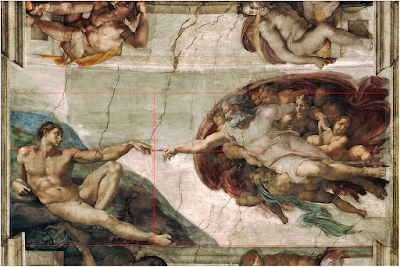We at the Center of Math have been inspired in unforeseen
ways by this beautiful weather. Our artistic sides are out and about! So, we've compiled this list of greatly varied pieces of art that are influenced by mathematics.
 |
| http://www.mcescher.com/gallery/mathematical/study-for-stars/ |
This woodcut from 1948 is titled Study for Stars. The mathematical influences are interestingly both
simple and abstract. Throughout the piece there are recreations of common
3-dimensional shapes – cones, cubes, etc. Drawn more intricately are depictions
of imaginary shapes that are real conceptually, but not otherwise. There’s the
cube ‘shoved’ into a diamond in the top left, and a shape that appears to be a
cube that is split in half and duplicated four times over. Judging from the
title, this seems to be Escher’s take on the various shapes and stages of
growth that stars can inhibit.
Creation of Adam (Michelangelo)- At first glance, The
Creation of Adam is simply a masterpiece. Unless you’re a math geek, there
doesn’t really seem to be any math involved at all. However, on second glance
and with a bit more of an analytical eye, viewers can see the golden ratio (which we've described here) in
all of its beauty, and see that it converges at the most dramatic point in the
piece: when Adam and God are about to touch. This was not done on accident, and
serves as a deep indicator of Michelangelo’s understanding
of the human body. The team at Golden Number have done an excellent job demonstrating this occurrence. Spending a day or two at the Sistine Chapel will be one of
the most rewarding artistic experiences of your life, so if you get the chance to see
Michelangelo’s masterpiece in person, make sure you take advantage.
 |
| image: https://silverandexact.files.wordpress.com/2011/06/portrait-of-pablo-picasso-juan-gris-1912.jpg |
Portrait of Picasso (Juan Gris)- Cubism is the most modern of the art forms in this list, taking off in the late 1800s and early 1900s. Popularized by Matisse, Cezanne, and Picasso, Cubism has remained as a link
between modern art of the 21st century, and the famous painters that
inhabited life before the age of technology. The math in cubism is a little bit
more abstract than the geometry and ratio-based art works. Cubism is perhaps most
concerned with issues of perspective, and representing the fourth dimension
while remaining in the second or third. Cubes, spheres, cones blended together in
unexpected ways, resulting in pieces that aren’t necessarily flattering at
first-glance (or at all), but are certainly thought-provoking. Read more on cubism here.
In Juan Gris’ 1912 piece titled Portrait of Picasso, take note of the examples of symmetry, various
shapes that are represented, and the how piece seems to divide itself in half
from one corner to the opposite.
The Parthenon- Once the defining symbol of Athenian
dominance, this temple dedicated to the gods is officially a member of the hall of fame for famous buildings and structures. Besides the beauty in its simultaneously simplistic and complicated architecture, the Parthenon is a key example
of the various uses of the golden ratio. Yes, the same golden ratio that serves
as a backdrop in Michelangelo’s Creation
of Adam plays a primary role in the makeup of the Parthenon in Athens.
As you can see, the golden ratio is visible when approaching
the Parthenon head on. The magical formula encapsulates the
entire face of the Temple, touching on meeting points of columns and beams
throughout the temple. There are tons more examples of the golden ratio in the
Parthenon, too. Factor (#mathpun) in the fact that Euclidean geometry wasn’t
even around during the time of the Parthenon’s construction, and this is a
truly impressive combination of architecture and mathematics. There’s a case to
be made that the Athenian empire and its accomplishments are one of the biggest
contributors to birth of modern western civilization; you owe it to yourself to
check it out!
___________________________________________________________________________
Luca Pacioli said, “Without mathematics, there is no art.” It serves as a testament to these artists’ understanding that the integration of mathematics and art is what makes for a profound impact on the viewer, and will always be beautiful because it is intrinsically “correct”. Mathematics is found in art all over the world, and these are just four of our picks. Do you have a favorite piece of mathematical art? Let us know in the comments!



No comments:
Post a Comment